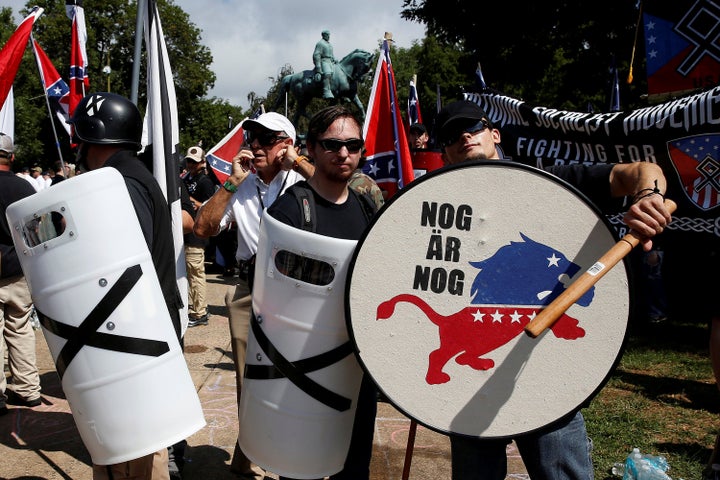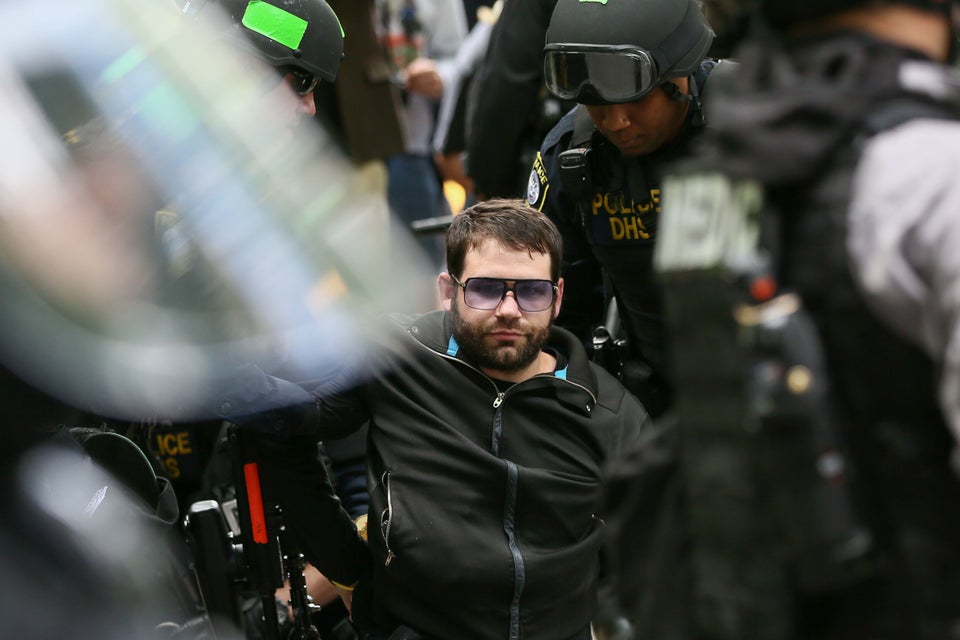
After Charlottesville, it’s important to understand that banning hate groups is a risky strategy that can create unintended consequences. This doesn’t mean that we shouldn’t ban hate groups. But it does mean that bans should be thought of less as strategies to combat the extremist fringe and more as symbolic actions to help shape and reassert the mainstream.
Banning hate groups is one of the most effective strategies in the fight against white supremacy and right-wing extremism — but not for the reasons you might think. This is because banning hate groups — whether through shutting down campus speakers, internet domains or financial services platforms — won’t permanently affect their ability to mobilize, organize, recruit or raise money. Bans are temporary. They are important not because of what they silence, but because of what they say.
For the past eight years, I’ve studied the varied ways in which right-wing extremist symbols, slogans and iconography are banned in Germany, from legal restrictions to school dress codes, for my forthcoming book, “The Extreme Gone Mainstream.” What I’ve learned is that bans matter because they establish clear moral boundaries.
“Banning hate groups is a risky strategy that can create unintended consequences.”
When companies ban hate groups from their clientele or universities expel students who participate in or celebrate violent acts, they draw a line that clearly conveys what they stand for. Bans send an unequivocal message that hate groups’ beliefs, statements and actions are so incompatible with mainstream values that their members and organizations are unwelcome as consumers, guests, speakers or visitors.
In so doing, bans help redraw with clarity the lines of what is mainstream and what is not. They express solidarity and support for members of vulnerable groups — racial and ethnic minorities, Jews and Muslims, immigrants and members of the LGBTQ community — who feel threatened, scared and alone in the wake of white supremacists’ and right-wing extremists’ hateful rhetoric. Importantly, they provide a sense of efficacy to those who otherwise may feel helpless in the face of hate. And they establish moral guidelines for others to follow.
So yes, bans matter — perhaps more now than ever — as a way of asserting moral leadership and clarifying institutional values. But what bans do not do is combat right-wing extremism itself. They are not an effective strategy to counter extremist ideologies. Even worse: bans often backfire, further fueling youth engagement in extremism by driving it underground and adding to disaffected youths’ sense of unfairness or injustice.
“Bans do not combat right-wing extremism itself. They are not an effective strategy to counter extremist ideologies.”
Nowhere is this more evident than in Germany, where legal restrictions on the use of the swastika and bans on other extremist symbols in places like stadiums, schools and clubs have led to the wide use of coded right-wing symbols that help extremists circumvent bans. The most common of these, the number 88, takes the eighth letter of the alphabet (H) to stand for “HH,” or “Heil Hitler,” and is used by American right-wing extremists too.
In Germany today, a wide range of alphanumeric codes are in play, many of which evolved in reaction to bans on the first wave of coded symbols like 88, 18 (for Adolf Hitler) or 28 (for Blood and Honor, the name of a banned group). For example, while I was doing fieldwork in the early 2000s for my first book, I learned that a German school had banned the number 88 from display. I then discovered that students started wearing T-shirts with the equation 100-12 on them. More recently, the right-wing scene has used the code “2yt4u,” relying on the phonetic pronunciation of the sequence to sound out the phrase “too white for you.” Over time, German legal restrictions and bans against far-right symbols are part of why games and codes are so popular with right-wing youth today — they always find new ways to manipulate symbols with evocative references, alpha-numeric sequences and mathematical equations.
Breaking bans and taboos is clearly appealing to young people. Extremist groups already serve as spaces for disaffected youths to express anger, betrayal and resistance and to lash out at mainstream society, whose expectations are often seen as unattainable. Messaging worn on the extremist clothing and merchandise I study in Europe includes language like “F*** your society,” “No rules” and “Rebellion.” Banning far-right symbols and groups can make rebellion even more central to the cause by giving the far right a sense of legitimacy in narratives about silencing or infringement of free speech, effectively tapping into their anger and desire to resist.
“We need to support and rely more heavily on the expertise of former extremists.”
While silencing and shutting down the far right can make extremism worse, bans are important in other ways. They are tools for strengthening and defining collective social norms and values, reminding a nation what it stands for and what it will refuse to tolerate. In this sense, the cascade of bans we’ve seen in the U.S. since Charlottesville is most important not as a tactic to combat white supremacy, but rather as a strategy to affect and communicate with mainstream Americans and those who are the targets of far-right rhetoric and hate crimes.
Effectively combatting hate groups will require a multi-pronged and long-term effort to better understand and interrupt the varied paths that lead young people into hate and violence. In addition to bans, policymakers, corporate and university leaders and others must commit to engaging in long-term work and in-depth strategies to prevent hate groups from further growing in the U.S.
To do this well, we need more research on the varied factors that contribute to youth radicalization and violence, and more evaluation of the effectiveness of counter-radicalization programs intended to interrupt or reverse those processes. We also need to support and rely more heavily on the expertise of former extremists and the range of organizations that work with youth who have dropped out or exited extremist scenes. Finding ways to combat growing polarization will also help. We need more dialogue across our differences and more opportunities for people from diverse backgrounds to work collaboratively in local communities, schools and neighborhoods in ways that build trust, empathy and understanding.

